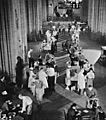Polio vaccine facts for kids
Polio vaccines are special medicines that help protect people from a serious illness called poliomyelitis, or polio. Polio can make people very sick and sometimes cause paralysis, meaning they can't move parts of their body.
There are two main types of polio vaccines used around the world. These vaccines have been very successful in stopping the spread of polio in most countries.
How Polio Vaccines Were Developed
The first polio vaccine was created by a scientist named Jonas Salk. He started testing his vaccine in 1952. On April 12, 1955, Salk announced his vaccine to the world. This vaccine is given as an injection, like a shot. It uses a poliovirus that has been made inactive, meaning it's "dead" and can't cause the disease.
Another scientist, Albert Sabin, developed a different type of polio vaccine. His vaccine is given by mouth, often as drops. Sabin's vaccine uses a "weakened" or attenuated poliovirus. This means the virus is still alive but has been changed so it's much less harmful. Human tests for Sabin's vaccine began in 1957, and it was approved for use in 1962.
Why Vaccines Are So Important
Polio is a disease that spreads from person to person. The poliovirus cannot live for a long time outside the human body. Also, there are no animals that carry the virus and spread it to humans. This means that if enough people get vaccinated, the virus can't find new people to infect. This stops the virus from spreading completely.
Because of these vaccines, polio has been almost completely wiped out. In 1988, there were about 350,000 cases of polio worldwide. By 2007, this number had dropped to only 1,652 cases! Vaccines are the key to getting rid of polio forever.
Images for kids
-
This 1963 poster featured CDC's national symbol of public health, the "Wellbee", encouraging the public to receive an oral polio vaccine.
-
Doses of oral polio vaccine are added to sugar cubes for use in a 1967 vaccination campaign in Bonn, West Germany
-
Example of OPV in dragee candy
-
Administration of the polio inoculation, including by Salk himself, in 1957 at the University of Pittsburgh, where his team had developed the vaccine
-
Mass polio vaccination in Columbus, Georgia circa 1961 for the National Polio Immunization Program
-
Albert Sabin (right) with Robert Gallo, circa 1985
-
A Somali boy is injected with inactivated poliovirus vaccine (Mogadishu, 1993)
See also
 In Spanish: Vacuna contra la poliomielitis para niños
In Spanish: Vacuna contra la poliomielitis para niños












